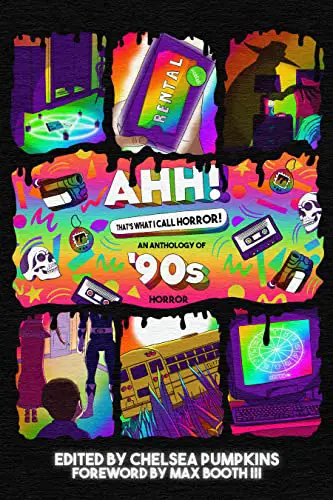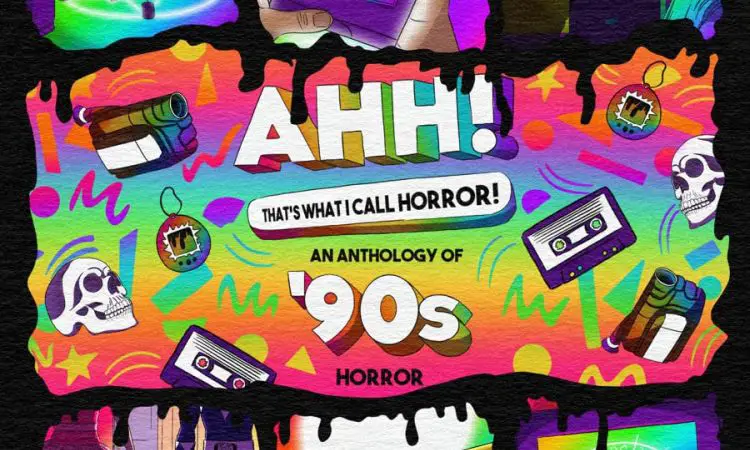What do I remember, specifically, about the ’90s? Hmm…
I remember seeing a folder with artwork depicting a creepy bus driver and the words “Back to school” written on it at the now-defunct department store, Caldor. I remember running through the sprinkler at the playground one warm May afternoon, then coming home to find a promotional video for Banjo-Kazooie in the mail. I remember spending Saturdays in the video store my Dad worked at (which naturally included a popcorn maker). I remember buying the Goosebumps books Say Cheese and Die and The Scarecrow Walks At Midnight at Walden Books. I know my original copy of Scarecrow was swapped with someone else’s because the order form in the back is different.
Do I miss the 90s? Yes. But I wouldn’t want to relive my childhood because it sucked. Nostalgia is a weird thing. You can’t live in the past, but if you don’t have a past how can you have a future? I’m of the mindset nostalgia mixed with honesty can be a force for good.
“Sometimes holding onto the past can build a better future.” – Dr. Leslie Thompkins, Batman: Haunted Knight
Which brings me to this new collection of horror stories set during the 1990s.


Ahh! That’s What I Call Horror is a project edited by Chelsea Pumpkins as a collaborative effort between several writers. In her own words:
It’s been a privilege and a blast to carry this anthology, which started as a communal project, over the finish line to readers’ bookshelves. And while I’m officially the editor, I couldn’t have gotten this far without the generosity of others. I’ve found that [the] horror community is particularly giving of their time, wisdom, and expertise and I hope I get to pay it forward to others someday.
This anthology specializes in ’90s nostalgia but avoids carrying the stories solely by nostalgia for that bygone era. The selection of tales is easily accessible for readers of every era, giving those born post-20th Century a taste of that final decade without alienating them. Keep reading for a preview of what’s in store.
- Madame Crystal by S.E. Denton – Adam is a programmer who signs up for daily horoscopes to impress a cute coworker. His disbelief turns to fear when the unassuming horoscopes not only come true but may somehow be connected to the Unabomber.
- The Harvest Queen by Bridget D. Brave – A girl looks forward to her first harvest dance as a teenager and learns what happens to people who peak in high school.
- Who In The World Is The Hat Man? by Chelsea Pumpkins – Your nights are haunted by a shadowy figure in a hat. You’re desperate to find out what it is and what it wants from you.
- Between the Barbie and the Deep Blue Ranger by Christopher O’Halloran – Afraid of his older sister’s wrath, a young boy receives conflicting advice from a Barbie and the Blue Power Ranger.
- The Grunge by Caleb Stephens – A famous rock star is accidentally brought back to life for one night by Colin and Patrick, two misfit fans in the small town of Gray Springs.
- Nona’s First and Last Album Drop by Edith Lockwood – A teen musician is determined to get her band’s song on the radio despite the local DJ screwing them over. Through that attempt, she discovers just how soulless corporate music can be.
- The One With The Mysterious Package by C.B. Jones – A smartphone from the future spells doom for a ’90s romance. Can love conquer all or will it destroy all of time and space?
- Caution: Choking Hazard by Matthew Wend – The holiday rush is a real killer when an obnoxious Karen gives a Cabbage Patch Doll and Tickle-Me-Elmo a taste for human flesh.
- Return to Gray Springs: Blockbuster Blues by P.L. McMillan – A surprising follow-up from The Grunge, three years later Colin and Patrick deal with a mysterious videotape and a dark secret behind the shelves of the local Blockbuster.
- Alive and Living (Pilot) – Live in front of a studio audience, and watch the escapades of the Parker Family. In this episode, young Brian conspires to take a trip to Minneapolis with his best friend Matt with help from an old book.
- The End of the Horror Story by Patrick Barb – [CENSORED] is getting a sequel taking the characters out of the usual summer camp setting and into frozen Siberia. The truth about the original’s most controversial scene might rear its ugly head.
- The Final Away Game by J.W. Donley – A high school marching band crosses more than state lines when they find themselves at the mercy of something eldritch.
- About A Girl by J.V. Gachs – A séance to contact the spirit of Kurt Cobain goes horribly wrong, leaving a teenage girl possessed by a young woman who died a horrible death.
- Threshold by Damien B. Raphael – A man finally receives answers about a friend who went missing in the 1990s and his connection to the owner of a video arcade and a homemade game called “Threshold.”
I’ve struggled for ages to discuss this collection, specifically because I’ve feared not being able to properly applaud it. Once you start with Madame Crystal, it’s amazing how Threshold finishes the book with a totally different atmosphere compared to the beginning.
Madame Crystal has you desperately hoping the story will end well for Adam, who initially comes off as a bit of a simp for Angela. His feelings for her take a back seat for most of the story after Madame Crystal’s horoscopes take a subtly sinister turn. The feeling of dread from the emails intensifies once Adam starts speaking with Madame Crystal directly, and you can immediately guess she, or it is going to screw Adam over big time. S.E. Denton does a good job of starting the anthology off strong.
The Harvest Queen surprised me as one of my faves. Bridget D. Brave gives us both a coming-of-age story and a town with a dark secret story that expertly plays with the latter trope. We follow Chloe as our protagonist, navigating the beginning of her teen years in the town of Sojourner’s Rest. In the days leading up to the Harvest Dance, we learn more about life in this small town, and the more we learn, the more we see just how utterly screwed up it is. What makes it even more disturbing is how Chloe herself doesn’t realize how terrifying her hometown is until the night of the big dance. Fans of Norman Partridge’s Dark Harvest should check this one out.
Who In The World Is The Hat Man is a story that really struck a chord with me. Chelsea Pumpkins’ writes a second-person POV, where you are the main character. You’ve had trouble sleeping for too long because your nights are haunted by a shadowy apparition you can only identify by the hat they wear. The Hat Man evokes a sense of fear but you gradually discover it’s not that scary, nor is it trying to hurt you. In fact, the Hat Man wants to help you. But are you willing to face what’s really haunting you?
As a survivor of adolescent sexual abuse, I wasn’t prepared for what I read but I am beyond grateful that Chelsea Pumpkins went in the direction she did. Her use of the fantastical and haunting as a force that is trying to help someone in the face of a very real and awful trauma said a lot to me, as someone who is trying to use their own writing to convey similar ideas. I just wish I had my own Hat Man to help me, accidentally or not, figure out what I didn’t understand so long ago.
Christopher O’Halloran’s Between The Barbie And The Deep Blue Ranger highlights the horrors of childhood, as little Joshua is forced to fend for himself between conflicting advice given to him by a life-size Barbie doll and a Blue Power Ranger. Maybe they’ll be more helpful to his older sister…
O’Halloran’s was actually the first one I read in the collection based on the title alone. I love that the story remembers how the Blue Ranger was supposed to be the voice of reason. But how reasonable can he be when you’re dealing with a dead body at the bottom of the stairs?
Caleb Stephens and P.L. McMillan work together to build the world of Gray Springs, first introduced in The Grunge and revisited in Blockbuster Blues. I wasn’t expecting two of the stories in the collection to take place in the same world, and from different writers at that, but it was a pleasant surprise all the same. The Grunge is more of a bittersweet comedy where buddies Patrick and Colin accidentally revive Scott Stark, lead singer of Soundwave. Blockbuster Blues takes place a few years later and has a much darker tone, where McMillan expands on the lore Stephens establishes as we find out how horrifying life in Gray Springs really is.
Several stories show that some struggles are unfortunately timeless. Edith Lockwood’s Nona’s First and Last Album Drop highlights the struggles of independent artists against big media corporations, and just how alien and heartless said corporations can be. Literally. Matthew Wend’s Caution: Choking Hazard can seem all too familiar for those of us who’ve worked in retail and know beyond a doubt the customer is never right, and that we all suffer when some people don’t respect boundaries or take “No” for an answer.
Carson Winter and Patrick Barb delve into the idea of lost media and found footage with their stories. Winter’s Alive And Living (Pilot) is framed as if we’re viewing an episode from a cliché sitcom that immediately goes off the rails into something much darker. The fun doesn’t stop there as the narrative implies that the audience is as eldritch and inhuman as the episode in question, making you wonder just who is this for. Barb’s The End Of The Horror Story is set up as an attempt to create a new entry in a dying horror franchise, an interesting blend of both The Blair Witch Project and Friday the 13th. Imagine my surprise to realize Barb is subtly referring to a scrapped Friday sequel which would’ve been set during winter.
J.W. Donley’s The Final Away Game and J.V. Gachs’ About A Girl delve into what happens when we trespass, whether knowingly or unknowingly, into the forbidden. Donley’s tale is about a high school marching band that accidentally crosses a boundary between the real world and something inhuman. Along the way, they find themselves fighting against something straight out of Lovecraft. Gachs’ story also touches on the idea of trying to channel a dead musician, in this case, Kurt Cobain, but instead has a teenager being possessed by an abused girl looking for payback.
And finally, we see that the past can haunt the future, but the future can also haunt the past. C.B. Jones’ The One With The Mysterious Package features a smartphone somehow being delivered decades back into the ’90s in an attempt to change the passage of time. Damien B. Rapheal’s Threshold is about unanswered questions from the ’90s haunting a protagonist into the future, concerning a missing friend, a series of numbers, and an old video game.
These writers all brought a little something different to the table in an anthology you desperately need in your life, regardless of when you were born. For a nostalgia-driven work of fiction, That’s What I Call Horror completely defies the stereotype of “REMEMBER WHEN THAT THING HAPPENED IN THE ’90S THAT WAS SO 90S? BECAUSE IT WAS THE ”90S YOU SEE!” They channel experiences some of us may have lived through, and some of us I hope definitely did NOT live through, to create a compelling grouping of horror tales. I honestly don’t know if I’m giving the collection proper justice in this article. All I can say is it’s really, really good.
Post Views:
8


